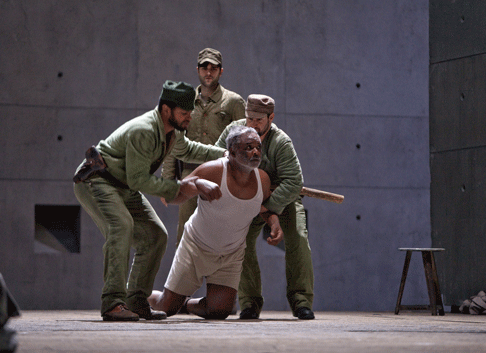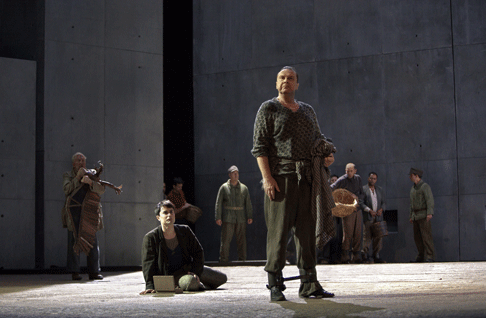17 Nov 2009
From the House of the Dead at the MET
Leoš Janáček’s From the House of the Dead is a very odd duck to find on the stage of a grand opera house.

Leoš Janáček’s From the House of the Dead is a very odd duck to find on the stage of a grand opera house.
The libretto is taken from Dostoevsky’s plotless collection of “notes” from his years in a Siberian prison camp, anecdotes and word-pictures of the tedium and occasional horror and joy of that existence, lacking immediate effect but packing cumulative punch. Janáček, naturally, picked and chose among these brief tales, and there is no single character, single drama with which he (or we) identify or follow: his protagonist is humanity, guilty, often criminally guilty, but never to be denied the sympathy and pity Janáček had earlier so sublimely evoked for Jenufa, her murderous stepmother and her two selfish lovers.
There being no real story in the opera, the men sing mostly of nostalgia or of the crimes that got them into trouble, and Janáček’s score provides soaring, lyrical, nostalgic themes to mitigate the harsh, percussive, maddening rhythmic passages. This is the same method he had used to tell the stories of Jenufa and Katya Kabanova, but both those stories had heroines we could follow with bated breath. We know none of the men in From the House of the Dead nearly so well, and our pity is hampered by that queasy unknowing: what other side of their character are they concealing? The beautiful Daghestani boy, Alyeya, for example, who charms us with his wish to learn to read, took part in a murderous attack on a peaceful Armenian caravan, though Janáček leaves that story out. The message appears to be: Whatever they have done, and whether they deserve punishment or not, they are your fellow human beings and you will pity them, empathize with them. It is a very humane message, and relevant to every age.
But that very absence of specificity makes the opera difficult to stage except on intimate terms, and the enormous Met is not intimate. In an attempt to deal with this, Alyeya is always kept downstage right so we can remember who he is, and titles, in addition to appearing on the backs of the seats in front of us, are projected here and there on the stage — fine for the far-sighted, a nuisance for others, annoying to those who would like to concentrate on the score, and infuriating when (as happened several times opening night) the wrong title is projected too soon. It is doubtful that a tale at once so diffuse and so intimate could have been presented successfully at the Met at all without some sort of titling — the City Opera’s production a quarter century ago was a tedious failure, not played very well — but the stage pictures on this occasion, though performed with agility, did not always focus attention where it might have brought comprehension.
Or was my discomfort exactly the effect director Patrice Chéreau, in his company debut (greeted with standing ovation, as were the cast and orchestra), wished to produce? Chéreau is perhaps of the school that does not wish to comfort but disturb with opera, and this is an opera not intended to provide comfort. In that light, the decision to perform it in one intermissionless hour-and-a-half act is the proper one, musically and dramatically.
 Willard White (kneeling) as Alexander Petrovich Gorianchikov in a scene from Act I of Janacek’s “From the House of the Dead,” with actors (left to right) Carlton Tanis, Collin McGee, and Marty Keiser.
Willard White (kneeling) as Alexander Petrovich Gorianchikov in a scene from Act I of Janacek’s “From the House of the Dead,” with actors (left to right) Carlton Tanis, Collin McGee, and Marty Keiser.
It might be instructive to compare From the House of the Dead to Beethoven’s Fidelio. The operas have in common their setting in a prison full of not-quite-hopeless men (all the prisoners in both operas are men) justly or unjustly convicted but in either case denied a human existence by the condemnation and willful ignorance of the society to which they once belonged. These are men that even societies that take pride in their commitment to personal freedom can restrict, despise, ignore — as the example of the enormous prison population of the United States attests.
In Fidelio, the story is frankly ludicrous: a woman disguises herself as a man in order to seek her husband in the prison system, and is so convincing (though rarely so to us) that the jailer’s daughter falls in love with her. But this story from opera buffa sets off the true matter: the heroism of the woman, her determined success in rescuing her husband. We are seduced by the opening everyday comic scenes, despite their prison setting and such reminders of another world as the glorious Prisoners’ Chorus that another world exists. When we explore the horrors in Act II, the very fact that such ordinary, even ridiculous people can ennoble themselves to such heights, can challenge and even conquer tyranny, makes a case for the nobility of the human race itself, even for us mere spectators. It is sublime theater, with the symbolic, cathartic effect theater was originally intended to have.
In From the House of the Dead, we are given no such easy key to let us choose the “right” side, to let us admire the “heroic” figure. Janáček, though born in 1854, is modern in his outlook, and though he died before the Nazis came to power, he could see where the century was going. His naturalistic theater shows us not cartoons of the human soul but (even in fables like Matter Makropoulos) something much closer to the human bone. His figures are none of them cardboard: In From the House of the Dead, the sadistic Commandant repents, the prisoners suffer but they continue their tedious lives. Dostoevsky explains that they made money by various handicrafts, all (and the tools to make them) forbidden by the authorities, and sold them in the village nearby for money immediately spent (lest it be found and confiscated) on vodka, warm clothes or the local whores. The enormous, forbidding cement walls of Richard Peduzzi’s set were in fact quite unnecessary in Siberia — if a man escaped, especially in shackles (the Met cast wear shackles), he had nowhere to go and soon perished in the wilderness. But the set, if not Siberian, gives us the right symbol for staging a prison camp, and the spectacular scene change at the end of Act I (no, I’m not going to spoil it) is a jolt that makes the prisoners’ endless plight seem especially unnerving.
 A scene from Janacek’s “From the House of the Dead” with Heinz Zednik as The Old Prisoner (left, holding eagle), Eric Stoklossa (on ground) as Alyeya and Stefan Margita (right) as Filka Morozov.
A scene from Janacek’s “From the House of the Dead” with Heinz Zednik as The Old Prisoner (left, holding eagle), Eric Stoklossa (on ground) as Alyeya and Stefan Margita (right) as Filka Morozov.
The staging puzzled me because it was unclear which character was which, or to remember him from earlier moments — costumes did not help, and faces were vague from Row W, an effect that can only have been enhanced upstairs. Too, the “mimes” the prisoners put on in Act II for an audience of visiting townsfolk seemed not at all the gently ironic variations on themes of obsession that such men might provide for respectable visitors, but heavily, brutally sexualized for the benefit of the twenty-first-century operagoer instead. It was not believable. If the men are capable of such ironic creativity, it puts their agony elsewhere in question. On four hours’ sleep a night, sleeping on planks with thirty other men (Dostoevsky’s description), would such rampant sexuality survive?
On the musical side, under the superb direction of Esa-Pekka Salonen, in his house debut, the Metropolitan Orchestra made a case for this work as an organic unity, its bitter percussion and soaring lyricism tautly held in a theatrically fulfilling symphony. This was music-making to cherish on every level, every rhythm crisp, every melody reaching for our heart and falling short only because it was in chains. Janáček’s humanity has never been more joyously in evidence. My desire to go to this production again had little to do with the staging and everything — besides Janáček’s own fine work — to do with Salonen and the Met Orchestra, and a yearning to hear such music again.
The singers were all able and so drawn into the acting of the piece that they seemed to take few “vocal” moments — they came across as presenting “conversational” drama. Willard White and Eric Stoklossa brought poignance to Gorianchikov’s tutoring of Alyeya — it is an interesting point, one neither Dostoevsky nor Janáček underlines, that when Alyeya is asked what miracle of Jesus he most admires, he mentions the tale of Jesus molding a clay bird and having it come to life and fly away — which connects in the opera to the image of an injured eagle, cared for by the prisoners and liberated in the concluding image. Although Alyeya is being taught to read with the Gospels, that story is not to be found there, but comes from the Koran, where Jesus is also an honored prophet; Alyeya, who is Muslim, heard it back home in Daghestan and never forgot it. Vladimir Ognovenko was effective as an apologetic, drunken, brutal Commandant, Kurt Streit an impressive Skuratov, and Kelly Cae Hogan displayed some wonderful contralto lines as a prostitute.
The star turn of the evening — which does not play as a star turn — belongs to Peter Mattei as Shishkov, so fine a singer one regrets when he turns to such unlyrical roles, so fine an actor that one hardly notices how brilliantly he is singing. Shishkov calls to mind the Yugoslav statesman Milovan Djilas’s comparison of Serbs and Russians — “Serbs are simple Slavs; a Serb will kill you. Russians are complex Slavs; a Russian will kill you and then weep.” He is haunted by the progression of evil deeds that led to his luckless marriage to the woman he then murdered — too, the man has obviously been drinking, bad vodka presumably — and his story, which occupies most of the last scene of the opera, holds us riveted as if Janáček had made that story into an opera, as he easily might have done. There is activity all about the stage during this narration, behind and around Mattei and in the high reaches of the monstrous set, but he never loses our attention for an instant, and his singing is as wonderful as his acting.
John Yohalem